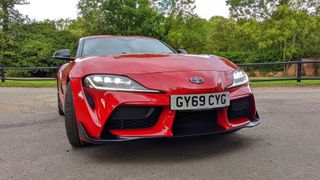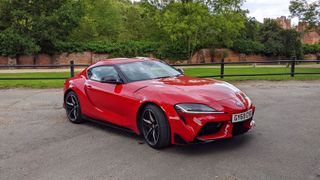Toyota GR Supra: head-turner, smile-raiser, conversation starter
The Supra is back, and it's a stunner

The Toyota Supra turns heads. Raises smiles. Sparks conversations. Everyone wants to comment, and it's always positive.
We've been lucky enough to have driven many cars, but few have garnered quite as much attention as the Toyota Supra. After more than 15 years without a new GR Supra, it finally returned in 2019 and a year later the fifth generation model is still a rarity on the roads, which is part of the reason it captures the attention of those around it.
Another reason is its looks. The curvaceous body, with flared rear wheel arches and various grills and vents across its frame, the Supra doesn't look like many other cars on the road - and while it's not cheap, it doesn't break the bank when it comes to performance sports cars.
The Toyota Supra price starts at $42,990 / £53,035, but we drove the Supra 3.0 Pro (Premium in the US) which starts at $54,490 / £54,340 and brings with it a number of additional features including an upgraded, 12 speaker JBL sound system, heads-up display (HUD) and wireless smartphone charging - although you'll get the same performance on both the 3.0 Pro and non-Pro models.
- Audi TT RS: supercar performance for sports car money
- Honda Civic Type-R: an everyday beast
- Lexus LC 500: a vision of the future
Toyota Supra design

Toyota GR Supra 3.0 Pro
Engine: 3.0L 6-cylinder
Power: 335bhp
0-62mph: 4.3 seconds
Top speed: 155mph
Fuel efficiency: 34mpg
Price: $54,490 / £54,340
The Toyota Supra is a beautiful car. We got positive comments pretty much everywhere we went - from the McDonald's drive-thru to delivery drivers dropping off packages at our house.
The Supra puts smiles on peoples faces, and sparks conversations. Its shapely form takes cues from previous generations of Supras, but updates them for a modern - if slightly futuristic - aesthetic.
There may be some debate about the rear, with the up-turn in the bodywork to form a sudo-spoiler reminiscent of the peak of a backwards baseball cap. It's a style we're fond of, but it's likely one of the more divisive points of the Supra's look.
Get daily insight, inspiration and deals in your inbox
Get the hottest deals available in your inbox plus news, reviews, opinion, analysis and more from the TechRadar team.
Slip into the low driving position and the Supra makes its powerful presence known. The bulging hood hints at the power in store, and a glance in the wing mirrors gives you an eyeful of rear wheel arch.
Flick your eyes towards the rear view mirror and the sight line through the back window is fine, but the raked glass means it's a relatively narrow view.
The sports seats are comfortable and wrap around your sides a little, allowing them to hug you when cornering - which reduces the amount your body moves, helping you to concentrate on the road.
The seats come with a heating option, warming you up on a cold day, and are electronically adjustable. There's a good amount of legroom and headroom. We were able to sit comfortably in the driver's seat and our 187cm frame didn't result in a collision with the roof.

This is a two-seater sports car, which means no back seats. Instead, if you look between the two front seats you'll see directly into the boot - with a raised section housing speakers ensuring items don't slide into the front under heavy braking. It also provides an easy way to stow a bag without having to open the trunk.
For smaller items, you can utilize the dual cup holders and key storage area between the seats, plus there's a wireless smartphone charging pad at the base of the center console, giving you a place to store your phone.
You could always chuck your keys and phones in the door pockets, but they're quite shallow, so you won't fit much in them.
If you have more sizable luggage with you, the Supra does have a good sized boot (for a sports car) and you'll be able to fit a supermarket shop in it without issue. There's enough space for a couple of weekend bags, or a large suitcase and a couple of smaller bags - providing you a good level of flexibility.
However, the opening to the trunk is a little on the narrow side, and the floor is lower than the opening, which may make heavy, or awkwardly shaped objects, a little more tricky to get in.










Toyota Supra drive
While the interior is comfortable enough, the main focus for the Toyota Supra is the driving experience. Forget the cup holders and the heated seats, what it's here to do is be driven, and boy does it like to be driven.
Once you've located the start/stop button, which is obscured by the steering wheel (just behind the wheel on the left), press it and the straight six cylinder, turbocharged engine comes to life. There are pleasant engine and exhaust notes that hint at the power, without being too overpowering.
If you want a racier sound, and stiffer suspension you can engage Sport mode which tightens up the steering and suspension for more serious driving endeavors.
Around town the Supra behaves quite well, comfortable cruising in traffic, but the accelerator doesn't need much caressing to start unleashing the Supra's 335 horses - so you may want to be a little delicate when pulling out at junctions in traffic.

Find a piece of open road and the Supra really finds its feet. Mash the go pedal and the power is delivered to the rear wheels. There's a momentary pause before the power is unleashed and hurtles you down the tarmac. With a 0-62mph time of 4.3 seconds, the Supra ain't no slouch, and it'll happily continue climbing until you hit its top (limited) speed of 155mph.
If you apply the power as you come round or corner, or driving when it's wet out, then the rear end will wriggle a little as the Supra balances traction with torque. The lively back-end is an endearing feature, giving the Toyota Supra a bit of personality and Japanese flair compared to some of its comparatively straight-laced European counterparts. In short, it's a whole lot of fun.
It really feels like you're driving the Supra, and its low center of gravity and light, responsive steering allows you to flick it through corners effortlessly.
The eight-speed automatic gearbox (borrowed from BMW along with the engine, frame and a bunch of the tech) works well, but the Supra also comes with paddle shift gears if you want more control over the up and down changes.

Toyota Supra specs and tech
An 8.8-inch touchscreen display is the focal point for infotainment in the Toyota Supra. It provides access to the satellite navigation, radio, media player and smartphone connection.
We found the interface relatively easy to use, although it did feel a little slow at times as it loaded up various screens. It's not the most current software we've seen on show, but it still works, and the satellite navigation provided clear directions and lane guidance.
Directions were mirrored in the instrument cluster, and also on the heads up display (HUD), which projects key information (including your speed and the road's limit) onto the windshield and into your eye line. This allows you to get pertinent information without taking your eyes off the road - which is pretty handy.
There's Bluetooth support, allowing you to connect your smartphone to the Supra, which in turns allows you to stream music and make and receive phone calls using the car's on-wheel controls.
You can use the on-wheel buttons to adjust playback volume of your music, and you can skip tracks, but you need to depress the scroll wheel firmly to perform the latter and it's not always successful.
The Toyota Supra doesn't offer Android Auto support, which means when you plug your handset into the USB port provided it will provide charge, but not the ability to mirror key apps on the car's display. iPhone users are in luck however, as the Supra does provide support for Apple CarPlay via the wired connection.
If you're lucky enough to have a smartphone with wireless charging, you'll be able to top it up without needing a cable thanks to the charging pad at the base of the center console.












Even if your phone doesn't support the wire-free charging tech, it's a safe place to store your phone when on the move.
Shift the Supra into reverse and you'll get the view from the rear camera - with guidelines augmented over it - on the 8.8-inch display, allowing you to safely navigate tight situations, plus there are parking sensors all the way around the car to keep your Supra free of scruffs and scrapes.
If you opt for the Supra Pro model, you'll be treated to an upgraded, 12-speaker JBL sound system which pumps out a pleasingly powerful audio experience. It's not the best we've heard, as the quality can distort slightly at higher volumes, but it's enough to get your motor runnin’ as you head out on the highway.
There's a bunch of driving aids available at your fingertips as well, from auto wipers and lights (including full beam), to adaptive cruise control and auto-dimming mirrors to reduce glare from the headlights of cars behind you - all of which work well.
The digital instrument cluster behind the steering wheel provides clear information on your speed and general trip information, plus there's an additional display to the right which is used for navigation directions.
Sadly this additional screen can't be customized to display different information. It's not a huge issue, but we'd have liked the flexibility to choose what info is shown.
If you're after a car which focuses on fun and the driving experience though, the Toyota GR Supra is an excellent offering. Its lively performance, eye-catching design and comfortable ride ensure it'll be enjoyed by you, and anyone watching it go by.
There's a good level of tech, and while it isn't the most feature-packed or modern, it all performs well, allowing you to focus on the fun stuff.

- John McCann is getting behind the wheel to give you an alternative look at the wealth of cars – and the tech inside them – available today. From super-fast sports cars to tech-packed hatchbacks, he'll take you through a range of makes, models, power and price tags in his regular TR Drives column.

John joined TechRadar over a decade ago as Staff Writer for Phones, and over the years has built up a vast knowledge of the tech industry. He's interviewed CEOs from some of the world's biggest tech firms, visited their HQs and has appeared on live TV and radio, including Sky News, BBC News, BBC World News, Al Jazeera, LBC and BBC Radio 4. Originally specializing in phones, tablets and wearables, John is now TechRadar's resident automotive expert, reviewing the latest and greatest EVs and PHEVs on the market. John also looks after the day-to-day running of the site.